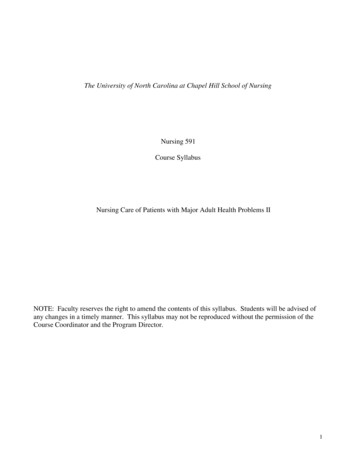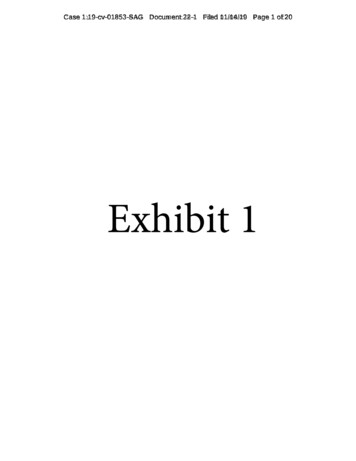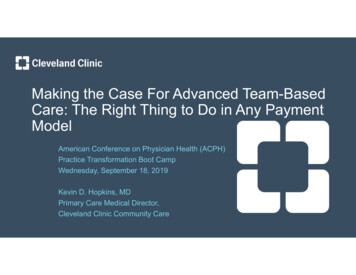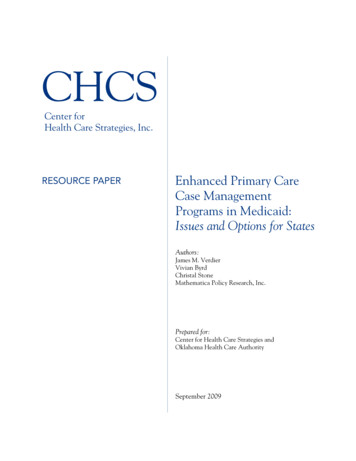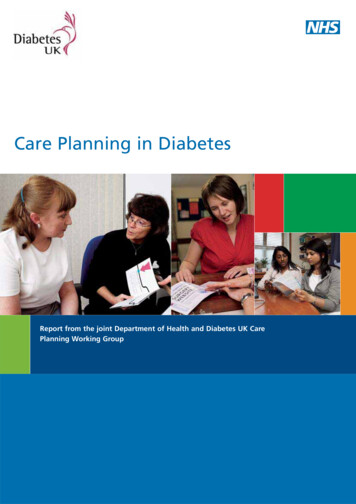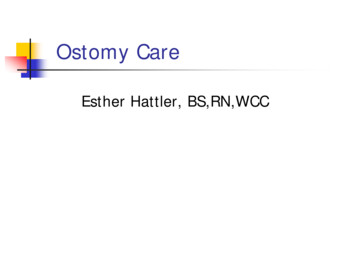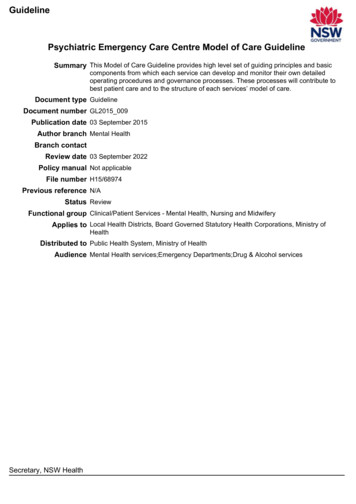
Transcription
Running head: NURSING CARE FOR A PATIENT SCENARIOCase Study – Nursing Care for a Patient Scenario (Mrs. Jones)Customer’s NameAcademic Institution
NURSING CARE FOR A PATIENT SCENARIO2Case Study – Nursing Care for a Patient Scenario (Mrs. Jones)Nursing Care PlanArea(s): Nutrition and HydrationNursing diagnosis (1). Nutrition: Imbalanced, less than body requirements related toinability to ingest or digest food or absorb nutrients because of physiologic alterations secondaryto medication regimen, as evidenced by weight loss of 10 kg in the past four months (or 14.3%weight loss from 70 kg in October 2009).Goals/desired outcomes. Within the duration of care, Mrs. Jones will be able to: Demonstrate interest/behaviors to improve her nutrition, thereby paving the way towardsproper nutrition and progressive regain of her previous weight (Doenges, Moorhouse andGeissler-Murr, 2004).Nursing interventions based on Doenges, Moorhouse and Geissler-Murr (2004, pp. 347352):1. Determine the client’s ability to chew, swallow, and taste or any dietary restrictions.Rationale: This determines the factors affecting ingestion, digestion, and food intake.2. Encourage the client to verbalize her thoughts and feelings about her current situation,diet, and nutrition.Rationale: This facilitates assessment and identification of the client’s very own needsand perceptions about her nutrition, thereby leading to individualized care.3. Encourage the client to choose foods according to her own preferences or foods that areappealing to her, with due consideration to any prescribed diet.
NURSING CARE FOR A PATIENT SCENARIO3Rationale: This stimulates the client’s interest and appetite, at the same time, consideringthe recommended diet for the client.4. Promote pleasant and relaxing environment as well as socialization.Rationale: Utilization of the environment to enhance food intake.5. Consult a dietician or nutritionist to cater for the client’s nutritional needs.Rationale: This facilitates experts’ advice and tailoring of a nutritional plan suited forMrs. Jones’s unique nutritional needs, as well as facilitating collaborative care.Nursing diagnosis (2). Failure to thrive, adult related to major disease(s) (uterine cancerand fracture of left neck of femur), as evidenced by apparent unintentional weight loss of 14.3%for the past 4 months.Goals/desired outcomes. Within the duration of care, Mrs. Jones will be able to: Demonstrate interest/behaviors and lifestyle changes to improve her well-being andnutrition.Nursing interventions according to doenges, moorhouse and geissler-murr (2004, pp.214-216):1. Perform physical and psychosocial assessment.Rationale: This is to determine the extent of limitations affecting Mrs. Jones’s ability tothrive.2. Explore Mrs. Jones’s previously used coping mechanisms that may be applied to hercurrent situation.Rationale: This refines or further develops the client’s coping strategies.3. Encourage the significant other’s (SOs) to participate in the management/care of theclient.
NURSING CARE FOR A PATIENT SCENARIO4Rationale: This strengthens the client’s support system, thereby enabling her to cope andthrive.Area: Skin IntegrityNursing diagnosis (1). Skin integrity, risk for impaired (Mrs. Jones’s risk factors: Fracturedleft neck of femur, old age, and altered nutrition, as well as braden pressure ulcer risk assessmenttool score of 16 signifying mild risk).Goals/desired outcomes. Within the duration of care, Mrs. Jones will be able to: Display interest/behaviors leading to reduced risks for impaired skin integrity.Nursing interventions based on Doenges, Moorhouse and Geissler-Murr (2004, pp. 465468):1. Provide information to the client and SOs about the importance of regular observationand effective skin care as well as proper nutrition and hydration.Rationale: This promotes skin turgor and reduction of risks for impaired skin integrity.2. Inspect skin routinely and observe for reddened/blanched areas and implement treatmentpromptly, if irregularities are evident.Rationale: This reduces the likelihood of progression to skin breakdown.3. Keep the client’s bed linen dry and free of wrinkles and crumbs.Rationale: This reduces the risks of skin injury by preventing pressure and possiblefriction.Area: ContinenceNursing diagnosis (1). Urinary incontinence, urge related to irritation of bladder stretchreceptors causing spasm secondary to Urinary Tract Infection (UTI).Goals/desired outcomes. Within the duration of care, Mrs. Jones will be able to:
NURSING CARE FOR A PATIENT SCENARIO 5Display behaviors/techniques to control/correct situation (incontinence).Nursing interventions:1. Measure Mrs. Jones’s amount of urine voided, especially noting amounts less than 100 ccor greater than 550 cc (Doenges, Moorhouse and Geissler-Murr, 2004, p.574).Rationale: This is to assess the degree of bladder disability to control urination.2. Regulate Mrs. Jones’s liquid intake at prescheduled times (with and between meals) andkeep a continence record for 3 days (Berman, Snyder, Kozier, & Erb, 2008, p. 1296;Doenges, Moorhouse and Geissler-Murr, 2004, p. 574).Rationale: To promote a predictable voiding pattern.3. Encourage Mrs. Jones to start and stop stream for two or more times during voiding(Doenges, Moorhouse and Geissler-Murr, 2004, p.574).Rationale: This isolates muscles involved in voiding process for exercise training.4. Teach Mrs. Jones about Kegel exercises or the use of vaginal cones (Doenges,Moorhouse and Geissler-Murr, 2004, p.574).Rationale: This is to strengthen the pelvic floor and enhance bladder training exercises,thereby counteracting incontinence and promoting proper urinary elimination.5. Encourage Mrs. Jones to consciously delay voiding (Doenges, Moorhouse and GeisslerMurr, 2004).Rationale: To gradually increase intervals between voiding to every 2 to 4 hours.6. Suggest to Mrs. Jones’s family to have an adequate lighting during nighttime as well as toinstall grab bars and elevated toilet seats as needed (Berman et al., 2008, p. 1298).Rationale: To promote comfort and safety.
NURSING CARE FOR A PATIENT SCENARIO6Nursing Diagnosis (2). Urinary elimination, impaired related to urinary tact infection (uti),as evidenced by incontinence.Goals/desired outcomes. Within the duration of care, Mrs. Jones will be able to: Display/verbalize understanding of the condition in order to achieve normal eliminationpattern. Demonstrate behaviors/techniques to prevent the further complication and recurrence ofurinary tract infection (Doenges, Moorhouse and Geissler-Murr, 2004, p.555).Nursing interventions:1. Inform the client that women are more susceptible to UTI because of the shorter size ofthe urethra (Berman et al., 2008, p. 1297; Doenges, Moorhouse and Geissler-Murr, 2004,p. 555).Rationale: To provide knowledge of the client’s condition, thereby promoting utmostunderstanding.2. Encourage Mrs. Jones and the SOs to drink adequate amount of fluids, that is, about eightto ten 8-ounce glasses of water or up to 3000 ml, with cardiac tolerance, daily (Berman etal., 2008, p. 1298; Doenges, Moorhouse and Geissler-Murr, 2004, p. 557).Rationale: To promote micturition (or urination), thereby flushing away themicroorganisms from the urethra (Potter and Perry, 2001, p.1411). Including thefamily/SOs in the health teaching/education facilitates involvement in the care of theclient. Nevertheless, cardio-clearance must also be taken into consideration to preventfluid overload.
NURSING CARE FOR A PATIENT SCENARIO73. Teach or instruct Mrs. Jones and female family members to wipe from front to back(from the urinary meatus toward the anus) every after voiding (Berman et al., 2008, p.1298; Doenges, Moorhouse and Geissler-Murr, 2004, p. 557).Rationale: Cleaning from dirtiest to cleanest area promotes asepsis, thereby preventingUTI.4. Encourage Mrs. Jones to complete the full course of the prescribed medication regimenfor UTI and inform her about the actions, adverse effects and other pertinent informationabout the drugs (Berman et al., 2008, p. 1298).Rationale: This is to ensure effectiveness of the treatment. Educating the client about theactions and adverse effects of the medications enables the client to promptly report anyuntoward reactions that the client may be experiencing.5. Monitor the effectiveness of the prescribed antibiotics and subsequently send the urinesamples to the laboratory (Doenges, Moorhouse and Geissler-Murr, 2004, p.557).Rationale: This is to evaluate the effectiveness of the medication regimen.Assessment ToolBraden’s Tool Score for Mrs. Jones – pre #NOF: 20 (See Appendix A for further details)Braden’s Tool Score for Mrs. Jones – post #NOF: 16 Mild RiskDifferences between 2 Scores:The difference between the above 2 scores signifies the apparent alteration of Mrs.Jones’s mobility. Her fracture predisposes her to pressure ulcer formation, though it is of mildrisk only (Braden’s Tool score of 16).Comment on Ease of Use (For Tool):
NURSING CARE FOR A PATIENT SCENARIO8The Braden Pressure Ulcer Risk Assessment Tool is somewhat easy to use because itprovides choices that enable us to clearly picture-out or depict the scenario, thereby leading us togive the appropriate score suitable for the client.Group Member Agreement/Disagreement of Assessment: The group was completely inconsensus about the scoring and assessment done.Any Problems with Tool Used:So far, there are no problems encountered with the use of the tool.Other Risk Assessment Tools Identified:1. Norton scale/norton’s pressure area risk assessment form scale was the first pressureulcer risk assessment reported in the literature. It scores five risk factors namely, physicalcondition, mental condition, activity, mobility, and incontinence, wherein the total scoreranges from 5 to 20 (Berman et al., p. 905; Potter and Perry, 2001, p. 1557).2. Gosnell scale developed from a research on 30 clients in a nursing home, this scale scoresfive factors that include mental status, continence, mobility, activity, and nutrition (Potterand Perry, 2001, p.1557).Frequency of Assessment:Constantly (Potter and Perry, 2001, p.1557).
NURSING CARE FOR A PATIENT SCENARIOAppendix APRE #LNOF9
NURSING CARE FOR A PATIENT SCENARIOPOST #LNOFNote: Image taken from “Government of Alberta – Seniors and Community Supports” (2010)10
NURSING CARE FOR A PATIENT SCENARIO11ReferencesBerman, A., Snyder, S. J., Kozier, B. & Erb, G. (2008). Kozier & Erb’s fundamentals of nursing:Concepts, process, and practice (8th ed., p. 905 & pp. 1296-1298). Upper Saddle River,New Jersey: Pearson Prentice Hall.Government of Alberta – Seniors and Community Supports. (2010). Braden pressure ulcer riskassessment tool. Retrieved F/58 braden assessment tool.pdfDoenges, M. E., Moorhouse, M. F., & Geissler-Murr, A. C. 2004). Nurse’s pocket guide:Diagnoses, interventions, and rationales (9th ed., pp. 214-216, pp. 347-352, pp. 465-468,p.555, p.557, & p. 574). Philadelphia: F.A. Davis Company.Potter, P. A., & Perry, A. G. (2001). Fundamentals of nursing. (5th ed., p.1557). St. Louis:Mosby.
NURSING CARE FOR A PATIENT SCENARIO 7 3. Teach or instruct Mrs. Jones and female family members to wipe from front to back (from the urinary meatus toward the anus) every after voiding (Berman et al., 2008, p. 1298; Doenges, Moorhouse and Geissler-Murr, 2004, p. 557). Rationale: Cleaning from dirtiest to cleanest area promotes asepsis, thereby preventing .
